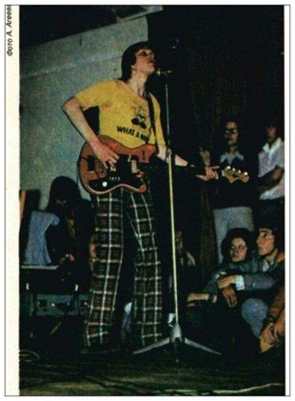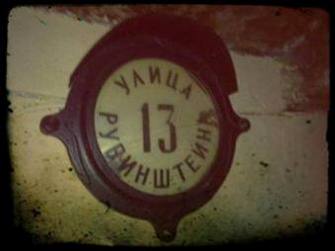Rock in the USSR
To understand the phenomenon of rock during the Perestroika era, it is necessary to recall the history of rock in the Soviet Union as a whole, as the rock of the Perestroika era originates from previous eras.
§ Background
It is believed that rock emerged from rock and roll, which originated in the United States in the mid-1950s. Rock and roll, in turn, was a blend of African American blues and rural Country music. The defining characteristics of rock and roll were its rhythm, danceability, and improvisation.
In the 1960s, The Beatles added European melodic elements to North American rock and roll, and the momentum continued to grow. Additionally, The Beatles popularized the concept of a group performance, which was a departure from the previous norm of solo performers like Frank Sinatra and others.
It is also important to note that The Beatles demonstrated that music could be created without formal musical education. This was a psychological breakthrough in the music industry. Consequently, the birth of rock is considered to have occurred in the 1960s in the West.
§ In the USSR

In the USSR, the situation was somewhat different. Rock music was considered ideologically foreign for a long time. Even the classical Beatles received criticism in Soviet newspapers. Perhaps the only echo of rock and roll that managed to make its way into the USSR on a legal basis was the dance called "twist".
However, the official stance and the reality of life in the USSR were different. The first rock bands emerged in the USSR in the 1960s. It is sometimes suggested that the first Soviet rock band was "Revengeurs" from the city of Riga, which started playing as far back as 1961.
In general, the Baltic states were pioneers in combining rock music with the conditions of socialism. In Estonia, during the same years, the ensemble called "Juniors" was formed under the leadership of Thomas Kõrvits. Interestingly, according to Kõrvits himself, the idea of creating the group was influenced by watching Finnish television, which somehow managed to be viewed by residents of the Estonian SSR.
It is widely known that X-ray films were used as semi-legal records in the USSR. In turn, bass guitars were made from regular Czech electric guitars by installing piano strings on them (due to the stiffness of such strings, fingers had to be wrapped in tape).
Often, fans of Western music didn't even know the names of the authors of that music. However, there were indeed Western recordings brought to the USSR by citizens working abroad, although the cost of these recordings ranged from 30 to 80 Soviet rubles (while the monthly salary of an engineer was around 140 Soviet rubles and a student's scholarship was 30-40 Soviet rubles). It was considered quite a luxury to acquire sheet music for rock hits from abroad.
This foreign origin prompted the early rock bands to simply imitate Western music. It took some time before writing lyrics in Russian became fashionable and relevant. Over time, the sharpness of the lyrics became the hallmark of Russian rock.
In Soviet and later Russian rock, it is the words that matter more than the rhythm. What is the reason for this? It is a fairly complex and multifaceted question. On one hand, it is undoubtedly the legacy of bards and singer-songwriters. Vladimir Vysotsky sang from every Soviet window in the 60s and 70s.
On the other hand, the music was influenced by the technological backwardness of the USSR in the music industry. There was some truth to all the jokes about the super heavy "Ural" electric guitar and the Soviet diesel synthesizer. But in one way or another, Russian rock turned out to be quite original.
§ 70s

Rock culture began to reach the remaining non-Baltic part of the USSR only in the late 1960s and early 1970s when the first rock groups started to emerge (in underground conditions, of course): "Mashina Vremeni" (1969), "Akvarium" (1972), "Visokosnoe Leto" (1972), "Auktsyon" (1978), "Piknik" (1978), "Zoopark" (1980), and other lesser-known bands.
The 1970s was a time of the formation of Soviet rock culture, a time of underground recording and rerecording studios, and late-night jam sessions in small Moscow and Leningrad cultural centers.
In 1978, a kind of rock festival was even held in the city of Chernogolovka, which was attended by bands from all over the country except for Leningrad. However, the attempt to organize a second similar festival ended in failure. Nevertheless, the improvised concert that took place as a substitute for the festival became the first breakthrough for the band "Akvarium" into the public eye.
§ Early 80s
A harbinger of the turbulent events of the decade, at its beginning, was the rock festival in Tbilisi in March 1980. Essentially, it was something that is hard to imagine. And although the festival had an unremarkable name - "Spring Rhythms", it had tremendous significance. The festival was even compared to the American Woodstock Festival.
The jury awarded first place to Moscow's "Mashina Vremeni" and Estonia's "Magnetic Band." Interestingly, the band "Akvarium" at that festival was disqualified for "inappropriate behavior on stage." As a result of the festival, the Soviet recording company "Melodiya" even released a record with some of the songs.

Of course, the question arises as to the reasons for such unprecedented ideological generosity on the part of the Soviet authorities. There are different opinions on this matter. Some believe that such liberalization was justified by the upcoming Olympics-80, while others believe that it was a cunning move by the KGB to create something like a database containing all the more or less famous rock musicians and their associates. In any case, it was an important milestone in the history of Soviet rock.
However, even in the 1980s rock underground, there were different levels. There were groups that were so nonconformist that the opportunity to perform on stage hardly promised them any change. They existed in a ghostly way, moving from one apartment to another. For example, there was a group called "Vladimir Ilyich Lenin," consisting, according to legend, of four people disguised as Vladimir Lenin.
Of course, concerts of such groups were only for their own, and in the case of recording on tape, the authors' names were not announced. By the way, in the 1980s, the so-called "magnitizdat" (tape recording) expanded the audience of rock listeners purely technically because it was quite easy to copy tapes.
And, of course, the rock history of the 1980s is inconceivable without the opening of the Leningrad rock club. This momentous event happened in March 1981. It was precisely here, on Rubinstein Street, 13, (in Leningrad) that the stars of the Perestroika rock came together. It was here that the group "KINO" took its first steps...
§ The Perestroika time
Perestroika essentially legalized rock music in the USSR. Everything that had been forming in the previous years simply became a reality. Officials and Komsomol workers, who had recently been at odds with rockers, now became co-organizers of official concerts and festivals. For example, the Moscow city committee of the Komsomol organized a four-day festival called "Rock-Panorama '86". Cooperative recording studios started to appear instead of underground recording studios.
In 1987, youth cultural centers emerged in Leningrad, which, like the Leningrad Rock Club, became platforms for young bands. The legalization of rock music expanded the audience of listeners, which greatly influenced the appearance of rockers. Bands started to seek their own style in clothing and hairstyles. A system of stage movements was developed, along with the use of stage lighting and smoke machines.

When discussing Perestroika's rock, it is necessary to consider the changed rules of the Soviet media, especially television. Perestroika television provided musicians with access to a multimillion audience and made 80s rock recognizable. The appearance on programs like "Musical Ring" and "Program A" essentially meant recognition.
During Perestroika, previously unprecedented international tours began, not only to socialist countries. Although sometimes the opportunity to tour had a negative impact on the creativity of rock bands. Endless performances minimized studio work, which made the repertoire almost non-renewable.
Perestroika's rock was no longer about intimate gatherings with wine in apartments or dimly lit club nights. It had become a mass stage event. The culmination of this can be considered the last concert of the band "KINO" at the Luzhniki Stadium on June 24, 1990, for which the Olympic torch of the 1980 Olympics was even lit. By the mid-90s, the Perestroika's rock ovement had faded.
Of course, some rock bands remained, new ones emerged, and they certainly played new chapters of Russian rock. However, the atmosphere of underground gatherings, the romance of train rides, and the sentimental protest against the existing reality remained forever in the era of Perestroika.
